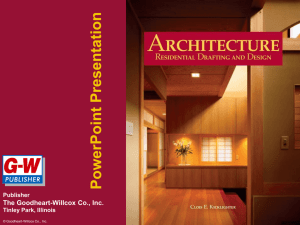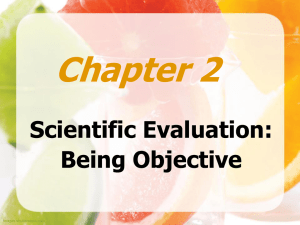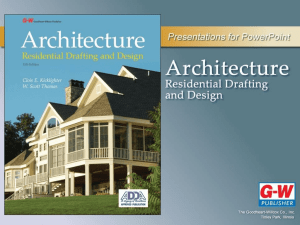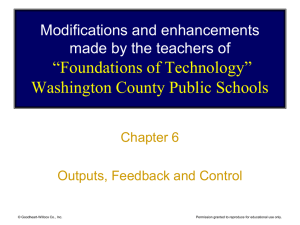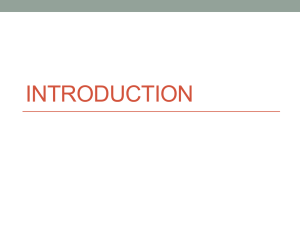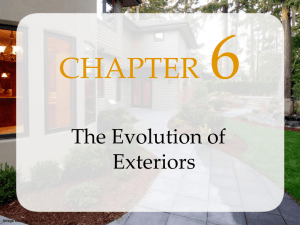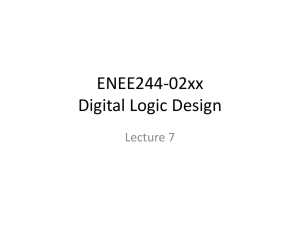Chapter 7 - Dyessick
advertisement
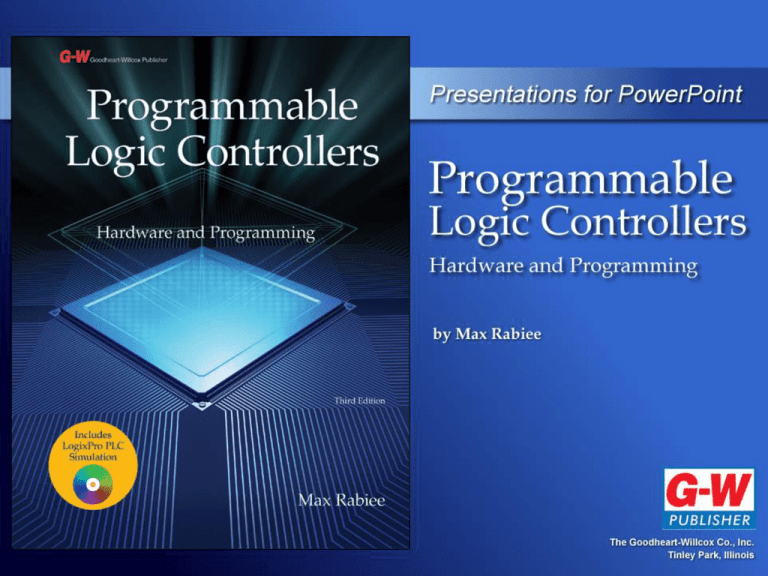
Chapter 7 Programming Logic Gate Functions in PLCs Objectives • Describe combinational and sequential logic gate circuits. • Create PLC ladder logic programs for NOT, AND, OR, NAND, NOR, XOR, and XNOR logic gates. • Create Boolean expressions and logic gate circuits from truth tables. © Goodheart-Willcox Co., Inc. Permission granted to reproduce for educational use only. Objectives • Use the Logic Converter instrument in NI Multisim to create logic tables and Boolean expressions from logic gate circuits. • Convert Boolean expressions to PLC ladder logic diagrams. • Convert PLC ladder logic diagrams to logic gate circuits and Boolean expressions. © Goodheart-Willcox Co., Inc. Permission granted to reproduce for educational use only. Combinational Logic Gates • • • • Do not require clock pulses to operate. Outputs depend only on their inputs. Outputs are generated instantaneously. Simply called logic gates. © Goodheart-Willcox Co., Inc. Permission granted to reproduce for educational use only. Logic Gates • • • • • • • NOT. AND. OR. NAND. NOR. XOR (exclusive OR). XNOR (exclusive NOR). © Goodheart-Willcox Co., Inc. Permission granted to reproduce for educational use only. Sequential Logic Devices • Have outputs that depend on their inputs as well as time. • Require clock pulses. • An inherent delay time is always present. • Flip-flop devices. © Goodheart-Willcox Co., Inc. Permission granted to reproduce for educational use only. Sequential Logic Circuit © Goodheart-Willcox Co., Inc. Permission granted to reproduce for educational use only. Boolean Expressions • Every gate logic function has its own equation called a Boolean expression. • Boolean algebra: – Two states are true and false. © Goodheart-Willcox Co., Inc. Permission granted to reproduce for educational use only. Boolean Expressions (Cont.) • True state: – Represented by the number one, called logic high or logic one in Boolean algebra. • False state: – Represented by the number zero, called logic low or logic zero. © Goodheart-Willcox Co., Inc. Permission granted to reproduce for educational use only. Boolean Expressions (Cont.) • Logic high: – Represented by the presence of a voltage potential. – Represented with five volts (+5 V). • Logic low: – Represented by the absence of a voltage potential. – Represented with zero volts (0 V). © Goodheart-Willcox Co., Inc. Permission granted to reproduce for educational use only. Truth Tables • In Boolean algebra, a table contains the digital input and output points. • This table is called a truth table. © Goodheart-Willcox Co., Inc. Permission granted to reproduce for educational use only. Gate Symbols • For every combinational and sequential logic device. • Used to create logic gate circuits. © Goodheart-Willcox Co., Inc. Permission granted to reproduce for educational use only. NOT Gate • Output is the inverse of the input. • Sometimes called an inverter. • Function is simulated by the electric circuit displayed. © Goodheart-Willcox Co., Inc. Permission granted to reproduce for educational use only. AND Gate • Two-input AND logic gate symbol, its Boolean expression, and its truth table. © Goodheart-Willcox Co., Inc. Permission granted to reproduce for educational use only. OR Gate • Two-input OR logic gate symbol, its Boolean expression, and its truth table. © Goodheart-Willcox Co., Inc. Permission granted to reproduce for educational use only. NAND Gate • Two-input NAND logic gate symbol, Boolean expression, and its truth table. © Goodheart-Willcox Co., Inc. Permission granted to reproduce for educational use only. NOR Gate • A two-input NOR logic gate symbol, its Boolean expression, and its truth table. © Goodheart-Willcox Co., Inc. Permission granted to reproduce for educational use only. XOR (exclusive OR) Gate • XOR logic gate symbol, its Boolean expression, and its truth table. © Goodheart-Willcox Co., Inc. Permission granted to reproduce for educational use only. XNOR (exclusive NOR) Gate • XNOR logic gate symbol, its Boolean expression, and its truth table. © Goodheart-Willcox Co., Inc. Permission granted to reproduce for educational use only. Simplifying Boolean Expressions • To convert a truth table to a PLC ladder logic diagram: – Find its simplified Boolean expression. – Use the gate logic to PLC ladder diagram conversion routine to create the PLC ladder logic diagram. © Goodheart-Willcox Co., Inc. Permission granted to reproduce for educational use only. Simplifying Boolean Expressions (Cont.) • Three methods used to simplify Boolean expressions: – Karnaugh maps. – Quine-McCluskey routine. – Electronic simulation software. © Goodheart-Willcox Co., Inc. Permission granted to reproduce for educational use only. Karnaugh Maps (K-Map) • Graphical representations of truth tables. – Use columns and rows to represent each term in a truth table. – For an n-variable input truth table, there are 2n boxes in a Karnaugh map. – A box for every line in the truth table. © Goodheart-Willcox Co., Inc. Permission granted to reproduce for educational use only. Karnaugh Maps (K-Map) (Cont.) © Goodheart-Willcox Co., Inc. Permission granted to reproduce for educational use only. Using K-Maps • Use the following steps to simplify the Boolean expressions using K-Maps: 1. Select an appropriate K-Map that has the correct number of input boxes, such as two-input and three-input. As stated, for an n-variable input truth table, there will be 2n boxes. Therefore, for a two-variable (A and B) input table, there will be 22 boxes, or 4 boxes. 2. Plot only the terms in which Y = 1. © Goodheart-Willcox Co., Inc. Permission granted to reproduce for educational use only. Using K-Maps (Cont.) 3. Follow the rules below for grouping the 1s in the K-Map that lead to simplifying the expression. © Goodheart-Willcox Co., Inc. Permission granted to reproduce for educational use only. Using K-Maps (Cont.) • Each group must contain an even number of binary 1s. © Goodheart-Willcox Co., Inc. Permission granted to reproduce for educational use only. Using K-Maps (Cont.) • Every 1 in adjacent cells must be included in a group. • The same 1 can be used in two or more overlapping groups. Each group should be as large as possible. © Goodheart-Willcox Co., Inc. Permission granted to reproduce for educational use only. Using K-Maps (Cont.) • Map can be considered closed, so that end boxes are grouped adjacently (top and bottom, or left and right). © Goodheart-Willcox Co., Inc. Permission granted to reproduce for educational use only. Using K-Maps (Cont.) • How groups wrap around the K-Map. © Goodheart-Willcox Co., Inc. Permission granted to reproduce for educational use only. Using K-Maps (Cont.) 4. Write the Boolean expressions for each group, and then simplify the expression. © Goodheart-Willcox Co., Inc. Permission granted to reproduce for educational use only. Using K-Maps (Cont.) 5. Sum common variables from each group to create simplified sum of product (SOP) Boolean expression. © Goodheart-Willcox Co., Inc. Permission granted to reproduce for educational use only. Quine-McCluskey Routine • For more than five input variables, a better method for simplifying Boolean expressions. • Complicated method that uses the Boolean algebraic simplification rules to find the simplified Boolean expression. • Might be used in an advanced course. © Goodheart-Willcox Co., Inc. Permission granted to reproduce for educational use only. Electronic Simulation Software • Easiest method to find simplified Boolean expression: – Enter input and output data. – Solves and simplifies the expression. – NI Multisim is an example of this software. © Goodheart-Willcox Co., Inc. Permission granted to reproduce for educational use only. NI Multisim Software • Open NI Multisim program. • From the Instruments toolbar, click the Logic Converter icon. • Click a space in the work area to place the converter. • Double-click the Logic Converter image to open the Logic Converter dialog box. © Goodheart-Willcox Co., Inc. Permission granted to reproduce for educational use only. Creating PLC Ladder Logic Diagrams from Logic Gate Circuits • Convert each gate to its equivalent ladder logic diagram. © Goodheart-Willcox Co., Inc. Permission granted to reproduce for educational use only. Creating PLC Ladder Logic Diagrams from Boolean Expressions • Some manufacturers use Boolean expressions to program PLCs. Example • Create the PLC ladder logic diagram for the following Boolean expression. Y = A′ + B + CD + EB © Goodheart-Willcox Co., Inc. Permission granted to reproduce for educational use only. Creating PLC Ladder Logic Diagrams from Boolean Expressions (Cont.) • To create the diagram, each rung or each portion of a rung is created by replacing the Boolean letter with the inputs that match. © Goodheart-Willcox Co., Inc. Permission granted to reproduce for educational use only. PLC Ladder Logic Diagrams from Boolean Expressions © Goodheart-Willcox Co., Inc. Permission granted to reproduce for educational use only. Creating Logic Gate Circuits from PLC Ladder Logic Diagrams • Converting to logic gate circuits: – Find Boolean expression that represents ladder logic diagram. – Draw the logic gate circuit using the Boolean expression similar. – Use logic converter instrument in NI Multisim program to find truth tables and Boolean expressions. © Goodheart-Willcox Co., Inc. Permission granted to reproduce for educational use only. Creating Logic Gate Circuits from PLC Ladder Logic Diagrams (Cont.) • Create the logic gate circuit for the PLC ladder logic diagram displayed. © Goodheart-Willcox Co., Inc. Permission granted to reproduce for educational use only. Creating Logic Gate Circuits from PLC Ladder Logic Diagrams (Cont.) • Turn the PLC ladder logic diagram into a Boolean expression as shown in the ladder diagram. © Goodheart-Willcox Co., Inc. Permission granted to reproduce for educational use only.
